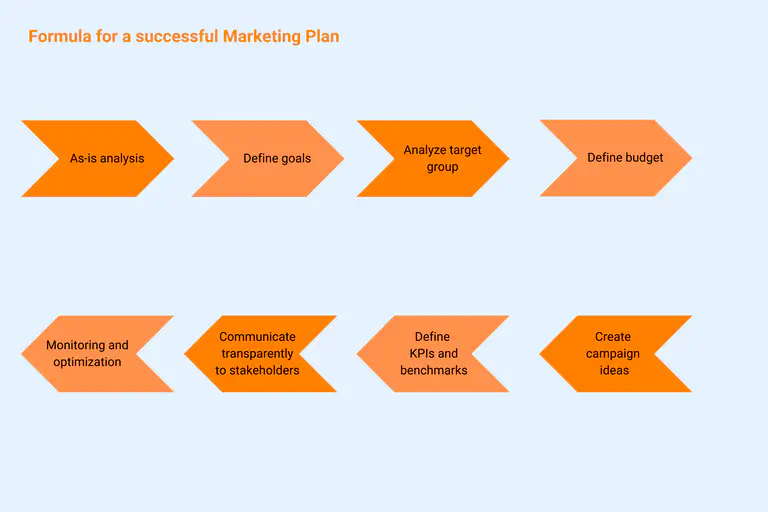Create a marketing plan in 6 steps #
Marketing is a central task for every company: it promotes brand awareness and product awareness, conveys important information to the customer and thus promotes business success. Writing a marketing plan is at the heart of successful marketing. It is the basis for all successful marketing activities. However, small and medium-sized companies in particular often lack the resources to create a carefully thought-out plan in their day-to-day business.
But what actually is a marketing plan? How do you go about it? What marketing plan content should you cover? We have created a 6-step plan with further tips on how to get from plan to implementation.
What is a marketing plan? #
A marketing plan is the basis for any effective marketing campaign. Think of it as a roadmap that describes all the necessary measures to address your defined customer groups and achieve your goals. Your plan should serve as a central document containing the current and future marketing activities within a defined period of time, as an important guide to action for your marketing department and also for the entire company. This provides your teams with a tool to prioritize, plan and implement measures in a structured manner and to communicate them consistently to the outside world. Depending on the defined goal and the overarching strategy, marketing plans can include activities across several channels or just for one channel. Examples of marketing plans are
- Social media plan
- Product marketing plan
- Online marketing plan
- Paid search plan
- Influencer Marketing Plan
- Content Marketing Plan
- Digital Marketing Plan

Marketing plan, marketing strategy, marketing concept: What does what mean? #
Before we delve deeper into how best to create a marketing plan, we should briefly clarify the terminology. This is because marketing concept, marketing strategy and marketing plan are often lumped together indiscriminately. However, they refer to different things that are all equally relevant and interdependent. The sequence is: develop marketing concept - work out strategy - write marketing plan.
- A marketing concept creates a strategic and operational framework for your activities. Similar to a marketing plan, there may be further concepts for individual sub-areas, such as online marketing or social media marketing, in addition to the overall marketing concept. Before you even think about concrete ideas, you should definitely create a marketing concept.
- The marketing strategy formulates the long-term goals and elements of the marketing concept in concrete terms. In this way, you formulate a basic path from the actual state to the planned target state. Once you have defined your strategy, you can derive a coherent plan from it.
- The marketing plan ultimately serves to implement your strategy operationally. You therefore first need a strategy, which in turn is preceded by the creation of a marketing concept, before you can write a marketing plan. Only then can you define concrete measures, determine budgets for individual channels and define specific targets and time periods for measures.
Why should you develop a marketing plan? #
With a well thought-out marketing plan, you create the basis for the successful work of your team. Without a clear plan, your measures will not be able to mesh with one another but will float side by side like soap bubbles and drift apart. In addition to concrete campaigns and individual measures, companies also gain other important insights:
Competitor analysis: Before you can create a marketing plan, you need to take a closer look at your market. Who are your competitors? How and where do they position themselves? This will give you a better understanding of the environment in which you operate with your offer.
Risk analysis: By knowing your market environment and analyzing your competitors, you can better identify risks and recognize them at an early stage. This allows you to manage risks effectively.
Preventing wrong decisions: A clear view of possible risks, clearly formulated objectives and well thought-out measures help you to avoid (expensive) wrong decisions.
Clear structures: A marketing action plan helps you to clarify and define the necessary structures and processes. This will increase productivity and employee satisfaction in your team.
If you work with a good plan, you also have the opportunity to define exactly the right options for action for the respective target and the respective channel and then tailor these to the needs of your target group.
How to create a professional marketing plan #
Every marketing measure is about achieving a specific goal within a specific period of time. Many different, necessary action steps must be planned, implemented, analyzed and documented. To ensure that your marketing team does not lose track, it makes sense to work with a digital marketing plan template. This helps you to communicate transparently, structure processes, prioritize tasks effectively and have an up-to-date overview of your projects at all times.
When writing a marketing plan, it is important to be guided by the requirements and ideas in your company. However, there are marketing plan contents that should definitely be included in order to really get the best results from your measures. You should include these five points in your marketing plan.

1. Analyze the current situation and define a strategy #
Before you can define the appropriate measures for your marketing projects, it is important to look at where you and your company currently stand. Get an overview of the status quo of your marketing department: What are the strengths and where are the weaknesses? What opportunities does the market offer and what are the possible risks? What unique selling proposition (USP) does your product or service have compared to the competition? How is the marketing department set up (personnel, resources, capacities)? Where are you now and where do you want to go - what is your vision? Also consider your competitors at this point.
Once you have defined the current situation, the next step is to determine what goals you would like to achieve in the near, medium and distant future.
2. Formulate your vision and objectives #
You now know where your marketing department stands. Now it’s time to find out which direction your marketing measures should take: What is your objective? The best way to do this is to use the SMART method and choose goals that are specific, measurable, achievable, relevant to the company’s objectives and time-bound. At this point in the creation of the marketing plan, also remember to define metrics and benchmarks or targets for later analysis. Once you have clearly defined everything, you can determine the start and end points of your marketing plan.
3. Take a look at your target group #
Before you start planning the specific steps required to achieve your goal, you should know who your target group is. Planning specific marketing activities without knowing for whom can work, but is usually associated with significant wastage. A careful target group analysis is therefore highly recommended: Who do you want to address with your activities? What are the characteristics of your target group? Which channels can you use to reach them? How do you attract and retain the interest of your target group (also in the long term)? Based on this information, you can then develop ideal-typical user personalities, so-called buyer personas, to which your measures are tailored when you plan marketing activities.
Take a little more time for this step and record all the information about your target group and your personas in detail. A marketing plan template will help you to structure your data clearly. After all, the target group is the decisive factor in determining whether a campaign is a top performer or a flop.
4. Determine your budget #
You now know your goals, your target groups and your competitors. The next step is to determine the budget you want to use to achieve your marketing goals. Define budgets for each marketing channel and always include a reserve. At this point, it is important to have a realistic picture of your own possibilities, both in terms of the resources you can invest and the results that can be achieved.
However, the size of the budget says nothing about the expected success of the campaigns. It is true that you will generally achieve greater success with a larger budget. However, this is only the case if your campaign is actually tailored to the needs of the target group and appeals to them, as there is no inevitable correlation between budget size and success. What is more important here is that you have worked properly in the third step and developed creative ideas. If you have done this, you can achieve good results even with low budgets; however, if you do not have a clear target group, you will hardly be successful even with high investments.
5. Fill the marketing plan with your ideas and measures #
Once the target group has been analyzed and the budget determined, the real fun begins and you can create your marketing plan and fill it with life. You now know your goals, your USP and your potential customers. Now it’s time to develop ideas and set up campaigns. If you haven’t already done so, think about which communication channels and marketing tools from the identified channel mix are really relevant. Determine interim goals and divide your campaigns into individual phases. Make sure you have a balanced mix of channels and measures in your marketing action plan. Be careful not to view your measures as individual, separate projects. Combine different channels and activities into a coherent customer journey to create a consistent brand experience, e.g. email, SEO, advertisements, events, your website, etc. It is also a good idea to use existing marketing plan examples and templates for this step.
6. Controlling and success analysis #
A good marketing action plan not only includes an overview of all campaign activities, but also documentation of the campaign’s progress. This reinforces a structured approach and also makes it possible to keep an eye on the progress and profitability of a campaign at all times. You can see immediately if a measure is moving in the wrong direction and can take countermeasures at an early stage. When you create a marketing plan, you should think about your monitoring and performance measurement at this point at the latest. Key figures, also known as metrics, can provide information on the success of your activities and optimization potential. In modern data-driven performance marketing, there is no shortage of figures, regardless of the channel. However, not every metric is equally suitable for making a reliable statement about the success or failure of a campaign. Again, the decisive factor here is the goal you are pursuing. Answer the following questions for yourself:
- Which key figures can you use to monitor and optimize measures?
- Which key metrics, the KPIs (Key Performance Indicators), can you use to evaluate the success of a measure?
- Do you need additional analysis tools?
- At what intervals should you evaluate measures?
- In what form and at what intervals should you report on the results? To whom?
Marketing instruments and analysis tools are part of every marketing plan. This allows you to see in black and white which measures were successful and which were less successful. This experience can be very valuable for subsequent projects.

From wanting to doing: Implementing the campaigns #
Your marketing planning is now complete, but the most important part is yet to come: implementation. This tip may sound banal, but it cannot be overemphasized. After all, you have probably already experienced creative ideas simply fizzling out - either because no one felt responsible or because the tasks were simply overlooked in non-transparent and confusing processes. However, creating a marketing plan is a complex process that takes a lot of time and cannot usually be managed by one person alone. It is an investment in the future success of your business. It is therefore important to ensure that these resources are not wasted.
Clear processes and transparent communication #
When you create a marketing plan and plan campaigns, work processes will inevitably be considered. Define clear processes and responsibilities. Communicate your plan within the company and get all affected departments on board. The best lead generation campaign will not produce useful results if your sales department is not aware of it and there is no communication before and during the campaign. Make your plan and communication transparent so that the team members and stakeholders involved are aware of the current status at all times. This will prevent unnecessary queries or decisions based on outdated information.
Marketing planning with digital tools #
Creating a marketing plan as a template on paper is one option - but not necessarily the most effective one. Or can you imagine everyone in the marketing team working with just one piece of paper on which they write down, correct, cross out, etc. all the project data? Digital tools for marketing planning are much less complicated, faster and more transparent. Whether Hubspot, SeaTable or Asana - digital marketing tools like these help you to bring all the information together, keep an eye on the timing and content and present everything clearly for everyone involved.
Measure, measure, measure: Optimization never ends #
You already know that it is important to consider the analysis and optimization of your campaigns when creating your marketing plan. Be aware that this is an ongoing process. You will probably extend the intervals over time. However, you should monitor your measures regularly until the end of the campaign and optimize them if necessary - or discontinue individual measures. Important: Act on the basis of the data instead of sticking to preconceived assumptions. It is equally important to regularly scrutinize and adapt your own processes. Are responsibilities unclear? Are the processes structured in such a way that everything is thought of? Do the workflows interlock? Are there any bottlenecks within the team that could jeopardize campaign schedules? You can create the necessary transparency with an online marketing plan. It is best to use a tool that enables collaborative work in real time so that your team members are always on the same level of information.

Conclusion: Create a marketing plan #
A carefully created plan is the basis for the success of your campaigns. It creates clarity about goals, channels, measures and the employees involved, defines responsibilities and improves organization and workflows within the team. If set up accordingly, you and your team will become more efficient and gain valuable time for what really drives your campaigns forward: the creative work. And it ensures the necessary transparency and coordination within the company. Use our six steps for your next marketing action plan to achieve your goals. And if you’re still worried that writing a marketing plan will take up valuable time that you’d rather spend elsewhere: With our free marketing plan template, you’re a big step closer to an efficiently created plan.
Get started right away with your customized marketing plan template #
Whether marketing campaign social media or editorial plan, competitor analysis, customer feedback or NPS questionnaire - SeaTable has ready-made templates for every marketing plan that include all important aspects and can be flexibly adapted to your needs at the same time. So you can get started with your marketing planning straight away. A digital template ensures that you can simplify your work processes and reduce your workload. With a digital tool like SeaTable, you can use your marketing plan to optimize processes, for example, and enable your entire team to work more efficiently and creatively. And these are not the only advantages:
- As a digital tool, SeaTable makes it possible to automate recurring activities across all project phases. This saves valuable time.
- Thanks to clear and detailed planning, the tool helps to organize projects transparently and to manage them in terms of time and content.
- As a central system that contains all information, SeaTable ensures that every team member knows the goals, measures and deadlines of a project and can therefore organize their work efficiently
- Whether texts, images or date values - SeaTable can work with any type of information. You also have the option of integrating other applications and tools into SeaTable for your marketing plan template - all clearly arranged in one place.
FAQ - Marketing plan #
What is a marketing plan?
What needs to be considered when creating a marketing plan?
When creating a marketing plan, there are a number of points that you need to consider when setting up a marketing plan, regardless of the company’s goals and products:
- Controlling and results analysis
- Actual analysis of your own resources
- Target definition
- Target group definition
- Budget
- Idea and action plan
Why should you use a cloud solution like SeaTable to create a marketing plan?
TAGS: Marketing Planning
